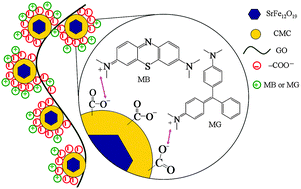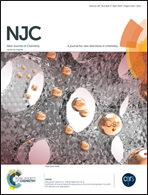A novel magnetic polysaccharide–graphene oxide composite for removal of cationic dyes from aqueous solution
Abstract
In this paper, carboxymethyl functionalized chitosan was used for the synthesis of a magnetic polysaccharide–graphene oxide composite (SCGO). Compared with the magnetic chitosan–graphene oxide composite reported before, adsorption capacity in this research had improved significantly. The calculated maximum adsorption capacity values for methylene blue (MB) and malachite green (MG) were 358.4 mg g−1 and 289.1 mg g−1, respectively. The morphology, chemical properties and physical structure of SCGO were characterized by scanning electron microscopy (SEM), Fourier transform infrared spectroscopy (FTIR) and X-ray powder diffraction (XRD). The influence factors which included pH, adsorbent dose, ionic strength and contact time on the adsorption properties of MB and MG onto SCGO were investigated. The adsorption kinetics of MB and MG on SCGO were well-described by pseudo-second order kinetic models. The experimental data of the isotherm followed the Temkin isotherm model and the Langmuir model, respectively. Thermodynamic analysis was also performed to calculate the changes in free energy (ΔG), enthalpy (ΔH), and entropy (ΔS). The results obtained from this research suggested that SCGO was a potential adsorbent for effective removal of methylene blue and malachite green.


 Please wait while we load your content...
Please wait while we load your content...